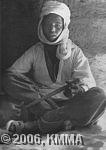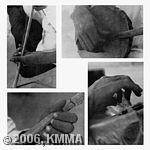















The keleli is a lute, generally with two strings, and is made by the musician himself. The sound box is a semi-circular gourd or a wooden or metal bowl covered with a moist, supple membrane, which is either camel, goat or zebra hide. Once the membrane is stretched over the sound box and attached with finely threaded strips of hide, the instrument is put in the sun to dry. This allows the hide to dry out and makes it tighten. Two incisions and one hole are made into the sound box and the neck of the instrument is inserted through the membrane. The neck is made from the wood of the date tree or another pliable wood. The incision is about the same size as the width of the neck and the neck is pushed through the incision. The other incision is made right next to the large hole, which measures 30 mm by 50. The loose skin over this hole is rolled around a small twig and folded back into the instrument. The neck passes through the membrane a second time, giving it its strength. Sometimes one or two small holes are made in the membrane with a heated point. The hair on the hide is carefully scraped off.
Most instruments have two strings, tuned to a relation of a third. The third string, if there is one, is tuned an octave from the string with the lowest tone and is called the 'chanterelle'. The strings are usually made from the tendons of a goat or a gazelle, but nylon is also used. The two strings are in fact one long tendon and shorter tendons are wound around them at the top of the neck and tied. At the other end of the neck the string is stretched over the neck. The chanterelle is also tied at both ends.
The keleli is a personal instrument, in other words every lute has its own musician and is not passed from one person to another. The instruments are not sold or traded either, but they are sometimes given as gifts or borrowed.
The musician plays the keleli sitting down or in a semi-reclined position, the sound box resting on the ground or on the player's foot or leg. The strings are stopped with the left hand and plucked with the right. Playing slackens the tension in the strings and gradually makes the instrument go out of tune. If the pitch deviates too much, the musician stops playing and retunes the instrument. The keleli is usually played solo, but is sometimes accompanied by voice sounds, a bourdon-like humming in the letter zzz, or a low, quiet whispering of a text.
Playing the keleli is taught as part of the children's education. They learn partly by listening and imitating, but mainly by self-tuition. The instrument is played from the time of circumcision to middle age. Older men do not play the keleli. The young men learn a set repertoire, 80% of which on the two-string keleli and 20% on the three-string keleli. The most important songs are: asilim, gini, bazabaza, kele, kae, toru, tardena, dogodoma, susuma, tin and tumtum.
The construction of the keleli is very similar to that of the kiiki fiddle. The only difference lies in the number of strings: the lute has two or three, whereas the fiddle has just one. They are also played in a different way: with the lute the strings are plucked, whereas the fiddle is played with a bow.
See also: BRANDILY, M., Instruments de musique et musiciens instrumentistes chez les Teda du Tibesti, RMCA – Human Sciences, Annals Vol. 82, 1974
© KMMA/Monique BRANDILY